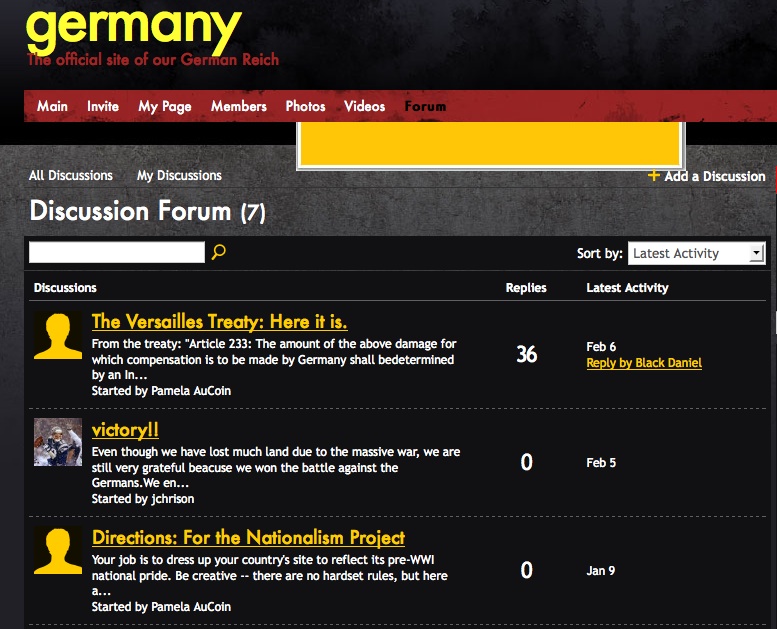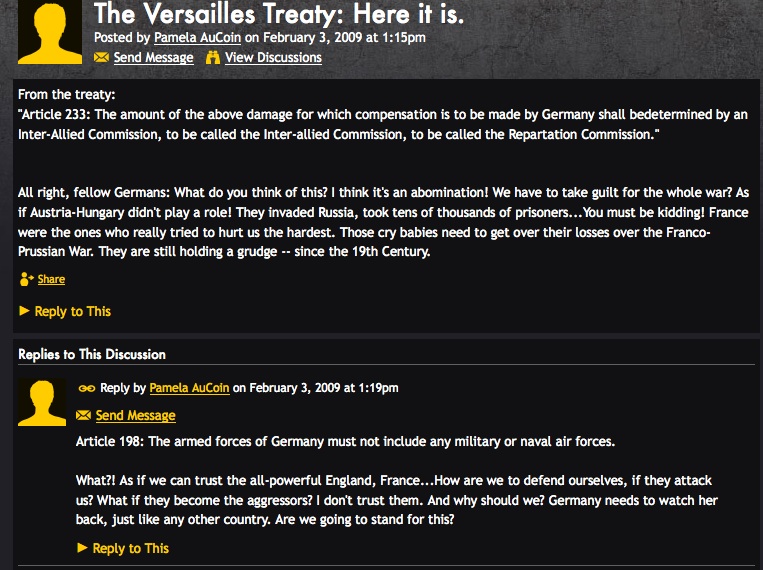| About the Grant: |
Students are using Social Networking sites; Facebook and Myspace are the new ways of hanging out, as virtual worlds become an extension of school hallways.
This project incorporates Ning to simulate World War One. Ning is a user-friendly site that provides a platform for creating one's own social network, which is not blocked by the Department of Education.
Simulating World War One is a unit-long assignment, which could be shortened: all steps need not be included. Students begin discussing the causes of World War One: nationalism, competition for colonies, and the assassination of Franz Ferdinand. Each student is assigned a country to represent. These steps are simulated on their Ning pages, just as they would on their own facebook pages: students provide a description of their countries, the accomplishments and concerns of their nation-state, and their reactions to what is going on in the world. It is social networking, writ large.
How it Works - Many teenagers are active social networkers, so there is a built-in interest, and understanding of the form and process. They engage in the same process of friending, blogging, and photo-sharing -- but from the perspectives of their assigned countries. They apply these skills to the causes, events, and results of the Great War.
Project URL http://serbiarules.ning.com/profile/pdasrat |
| How This Grant was Adapted: |
Final Project/Product -
Overall Value - It is essential students understand multiple perspectives. This project is a virtual simulation; students experience a cyber version of the causes, battles, and results
of World War One. Students research examples of nationalism, forge alliances, share battlefield experiences, and, finally, evaluate the Versailles Treaty. They work from the perspective of their own
country, and remain in character throughout, and develop their creative writing, research, and internet skills along the way.
Tips for the Teacher - Keep the activities structured, for the benefit of students who do not work well without strict guidelines. More creative students should have the opportunity to explore
other ways to contribute. They might choose to write relevant poetry, editorials, or even scan their own artwork.
|
| Project URL |
Project URL http://serbiarules.ning.com/profile/pdasrat |
| Objectives |
Objective 1: Students will be able to explain the direct and indirect causes of World War One.
Objective 2: Students will be able to research examples of nationalism.
Objective 3: Students will be able to write journal entries, newspaper articles, and poems which relate World War experiences.
Objective 4: Students will be able to simulate the alliance and nationalism phases of World War One.
Objective 5: Students will be able to research relevant battles during World War One.
Objective 6: Students will be able to explain why the Treaty of Versailles was controversial.
Objective 7: Students will be able to respond to the Treaty of Versailles from the perspectives of their assigned countries. |
| Websites Used |
Link 1: www.ning.com
Description: The social networking site used.
Link 2: http://fordham.edu/halsall/mod/modsbook4.html
Description: A rich collection of primary sources for student research.
Link 3: www.youtube.com
Description: Students can embed videos from this site. Youtube is a blocked site, but students with internet access can upload videos from home.
Link 4: google.com
Description: This has a good search engine for images. |
| Standards Addressed: |
Standard 1: Students will understand the development and connectedness of Western civilization and other civilizations and cultures in many areas of the world and over time
Grade: 10
Subject: Social Studies
Standard 2: Students will analyze historic events from around the world by examining accounts written from different perspectives
Grade: 10
Subject: Social Studies
Standard 3: Students will understand the broad patterns, relationships, and interactions of cultures and civilizations during particular eras and across eras.
Grade: 10
Subject: Social Studies
Standard 4: Students will analyze changing and competing interpretations of issues, events, and developments throughout world history
Grade: 10
Subject: Social Studies |
| Lesson 1: |
Title: Group Assignments and Learning to use the Ning
Objective 1: SWBAT practice using the ning.com website.
Objective 2: SWBAT review project guidelines.
Procedures -
Procedure 1: Assign students to groups of three to four.. Each group opens only one Ning account. Nationalism is a sensitive topic; I would not advise using this for World War II.
Procedure 2: Then students "friend" the other members in their group, allowing them to collaborate on the same project.(This is very easy to do. Just click on the "invite friends" button,
and type in email addresses of the members you want to friend. Make sure students friend you as well, so you can comment on their work as it progresses.)

Procedure 3: Distribute project guidelines and rubrics. Review as a class.
|
| Lesson 2: |
Title: The Causes of World War One
Objectives:
Objective 1: SWBAT brainstorm examples of nationalism.
Objective 2: SWBAT research examples of nationalism.
Objective 3: SWBAT discuss the advantages and disadvantages of nationalism.
Procedures -
Procedure 1: Brainstorm signs of nationalism (showing off flags, boasting about national cultural, sporting, and political achievements, etc.
Procedure 2: Examine examples of nationalism, for example pictures of English football fans, and the French flag.
Procedure 3: Discuss: Does nationalism serve a purpose? What are the pros and cons of nationalism?
Homework: Research examples of nationalism from your assigned country. Focus on the period before, and during World War One. |
| Lesson 3: |
Title: Forging Alliances
Objective One: SWBAT identify their allies during World War One;
Objective Two: SWBAT friend their allies on their ning sites.
Materials: Laptops with internet access.
Procedure One: Discuss: Why is it important to have friends (allies)? When can friendships be problematic?
Procedure Two: Groups identify the 'countries' which they were allied;
Procedure Three: Group members friend their allies using the "invite" feature on their ning sites
Procedure Four: Group members brainstorm how they will greet their allies. |
| Lesson 4 |
Title: Dressing up the Ning
Project Objectives
Objective 1: SWBAT research examples of nationalism for their assigned countries.
Objective 2: SWBAT create nationalistic ning pages.
Materials -.
Materials 1: computers with internet access.
Procedures -
Procedure 1: Students sit with their assigned partners.
Procedure 2: Laptops are distributed.
Procedure 3: Students share their examples of nationalism.
Procedure 4: Groups copy and paste visual examples, such as flags, etc. Other members copy song files and famous quotes from important national figures (like Otto von Bismarck of Germany, or Count Cavour of Italy.)
Homework: Read about your assigned battle. 1.Complete a "who, what, when, where, and why" chart. 2. What was your country's role? If it was not directly involved, infer what your nation's position
might have been. Explain your answer. |
| Lesson 5: |
Title: On the Battlefield
Objective 1: SWBAT explain their country's role during a specific battle.
Objective 2: SWBAT explain their country's position/role during this particular battle.
Objective 3: SWBAT blog from their country's point of view.
Materials -.
Materials 1: laptops with computer access.
Procedures:
Procedure 1: Take out homework assignments.
Procedure 2: Group members share their homework responses.
Procedure 3: Group members choose who will complete the following tasks: a journal entry (from a soldier, or from the home front), an interview with a general or foot soldier, and possibly a song or poem inspired by the event.
Procedure 4: Student work will be posted on the Ning.
Homework assignment: Research the final stages of World War One. Write an outline which details the final battles and stages of the war. |
| Lesson 6: |
Title: Exchanging views: Treaty of Versailles
Objective 1: SWBAT understand the key points of the Treaty of Versailles
Objective 2: SWBAT brainstorm responses to the Treaty from their countries' perspective;
Objective 3: SWBAT predict how the losers of World War One will respond.
Materials 1: Computers with internet access
Materials 2: Excerpts from the Treaty of Versailles.
Procedure One: Review the homework.
Procedure Two: Students read provisions from the Treaty. They answer the following: Who are the winners and losers? On which side is your country? How do you respond, and why?
Procedure Three: Student groups brainstorm their responses, and post them on their ning blogs. 
Final Day: Presentations: Students can evaluate each other's work. They assess the other groups' work, using the rubric as a reference.
|